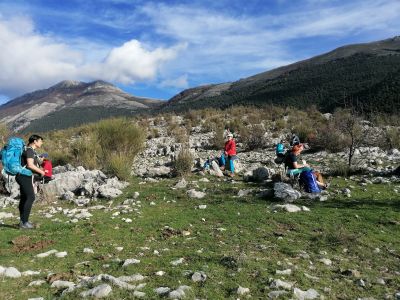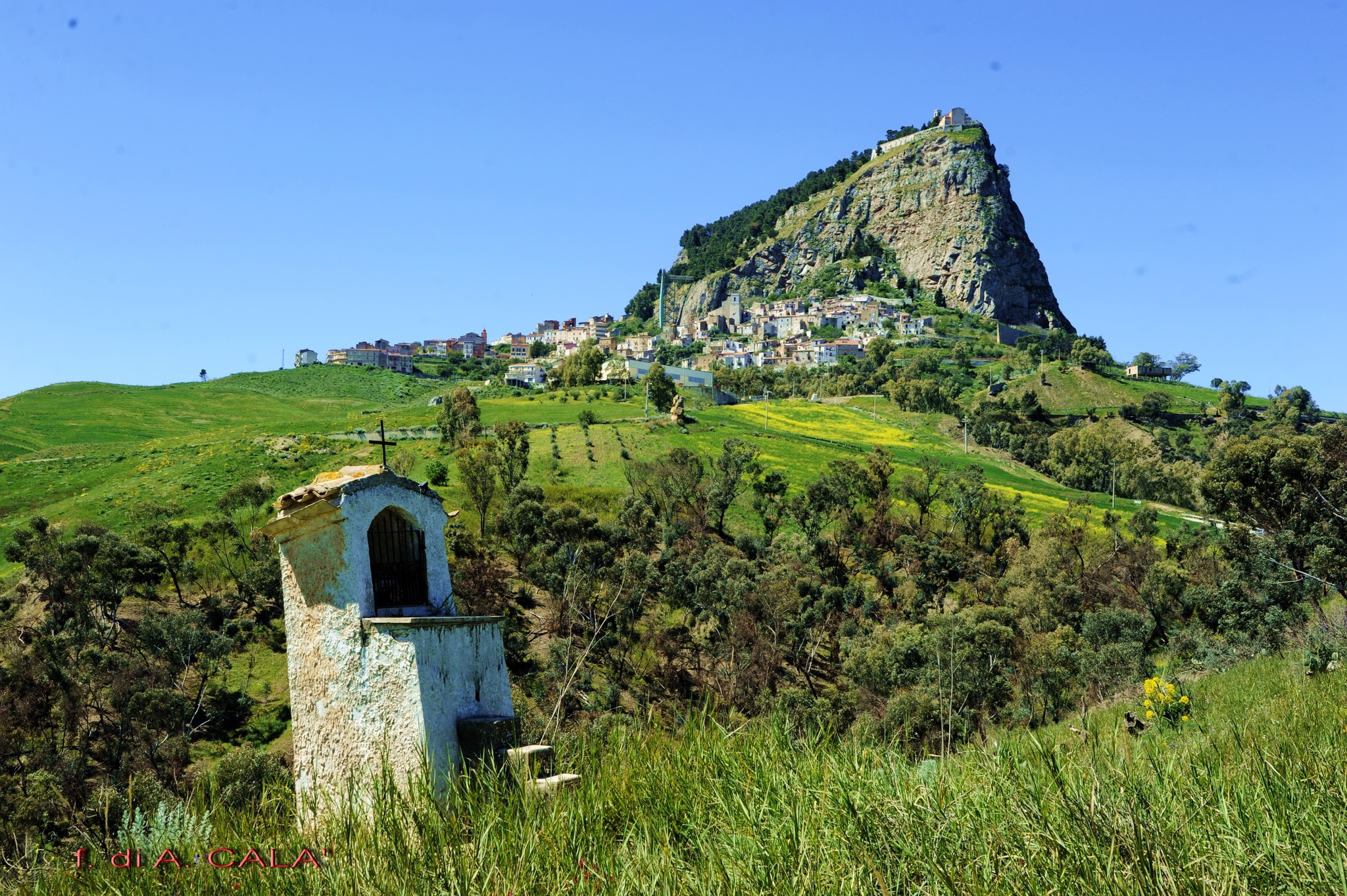In fact, the town is holed up in a fortress divided in half by a fissure - jacca - which legend attributes to the last breath of Christ on the cross.
If these places fascinate you, you can visit Sutera with one of our tours in Sicily:
⇒Magna Via Francigena: a piedi da Palermo ad Agrigento
What to see in Sutera
Why not decide to spend a carefree day to discover the beauties of this fascinating village in Sicily?
If you want to spend a day in Sutera, we have prepared a list of things to see and visit in peace:
- Church of Sant'Agata
- Ruins of the Solomon Palace
And now let's set off together to discover the most identifying places in Sutera!

Church of Sant'Agata
It overlooks the central Piazza Sant'Agata with its imposing fifteenth-century structure. Inside, in addition to a valuable carved wooden choir, the splendid marble statue of the Madonna delle Grazie and the precious canvas of the Madonna degli Innocenti are preserved.
Ruins of the Solomon Palace
Continuing along Roma street you reach the ruins of Palazzo Salomone where one of the thirteen heroes of the famous Barletta Challenge of 13 February 1503 was born. Today the perimeter walls and some internal parts made of a mixture of mortar and plaster are still visible. Also significant is the date visible on one side of the structure which identifies the date of the celebrations which took place in 1903 on the occasion of the commemoration of the 400th anniversary of the battle.
What to do in Sutera - the Slow Active Tours proposal
Once you have discovered the wonders hidden among the streets of Sutera, the time has come to get to the heart of the sounds and smells of this ancient village.
-
Visit to the Rabato district
The Rabato district is also characteristic, built by the Arabs around 860 AD Rabat in Arabic means village and still today retains some of the characteristics of a Saracen village such as the narrow alleys, the terraces and the walls of the plaster houses. In the shadow of Monte San Paolino which dominates the valley of the Platani river, the ancient village with a clearly medieval layout unfolds nestled between the narrow streets of lava stone and limestone.
-
Ethno-anthropological Museum
The ethno-anthropological museum of Sutera was inaugurated in March 2013 and houses within it not only the tools of the shepherd or farmer, but also those of the blacksmith from the late nineteenth century, the carpentry works of the 1930s and other tools handed down for various generations, some of which date back to the eighteenth century. The Museum is personally curated by Mario Toma, a middle school literature teacher, and conserves the posters and brochures of the concerts held by the country's only composer and musician at the beginning of the twentieth century, the posters that accompany the emigrants on their journey to the Americas, Northern Italy or Europe.
Interesting is the faithful reproduction of a typical late 19th century bedroom and the collection of objects that were used for bread-making and pasta. The Museum provides a glimpse of daily life until the early years of the last century, thus testifying to the improvement of the standard of living and the parallel scientific and technological progress. -
San Paolino Sanctuary
The diocesan sanctuary of San Paolino is located at the top of Monte San Paolino, a true balcony of Sicily with its 823 meters of height. The Sanctuary is accessed after crossing a characteristic street carved into the rock.
Along the way you can admire mystical and fascinating places such as the Stations of the Cross, the prison known as Philip of Anjou and the place where, in 57 AD, a cross was erected for the first time, in memory of the accession of the Suterese to the Christian faith. The Sanctuary is an imposing building with three naves, but with simple lines. It was built around 1370 by the then Baron Giovanni III of Chiaramonte. According to tradition, the Sanctuary was built with materials coming from an ancient fortress, most likely of Byzantine origin, the ruins of which still exist today but are not visible. -
Magna Via Francigena: from Palermo to Agrigento
Slow Active Tours offers an exciting and intriguing walking journey to discover the hidden beauties of Sicily from north to south, from the Tyrrhenian Sea to the Mediterranean Sea.
Festivals and Popular celebrations in Sutera
Sutera Living Nativity Scene. During the Christmas period, the charming Rabato district, with its narrow streets and abandoned houses, is the backdrop to an exciting and characteristic live nativity scene. During the journey, tastings of typical products contribute to creating a very suggestive atmosphere.
Pepper Festival is a much awaited popular festival which takes place at the same time as the festival in honor of the patron saint San Francesco. In fact, when the simulacrum returns to the church, a collective feast of fried peppers, boiled potatoes and hard-boiled eggs follows, all accompanied by an excellent local wine. On the Tuesday after Easter the Feast of San Paolino is celebrated, for this reason the anniversary is also called Pasquone (means “Big Easter”). On this very characteristic and evocative occasion, also due to the natural conformation of the territory on which it rises like a stone giant, the majestic fortress on whose summit stands the sanctuary of San Paolino, built in 1366 by Giovanni III of Chiaramontesi, where "the Casci Saints" San Paolino and Sant'Onofrio are celebrated.
Typical dishes of Sutera
The typical dishes of Sutera are greatly influenced by the ancient peoples who dominated this area for centuries. It is no coincidence then that seafood cous cous is one of the local specialties. This Arabic dish has become widely spread in Sicily and in the Trapani area in particular, and is truly a delight for the taste buds. The fish broth flavors the semolina well.
For those with a sweet tooth, however, the sweetest and most delicious flavors cannot be missing: the Genovese ones are right for you! This delicacy is nothing more than shortcrust pastry filled with pastry cream. The particular name derives from the curious shape of a Genovese hat that characterizes these delicious Sicilian sweets.
Eating and Drinking in Sutera
Here are some suggestions from the area:
Sambriglia in S. Giuseppe street 7. Sambriglia was born within the walls of an ancient convent and overlooks a romantic little square that looks like a balcony overlooking the valley. The chef, from a modern open kitchen, offers alternatives for all tastes.
I Sapori della Piazzetta in Via del Popolo street 8. Pastry shop, bakery and also restaurant. Ideal for a lunch or dinner based on typical products. Any advice? Try the "mbriulate".
So what are you waiting for? Get your stuff ready and off you go!



















